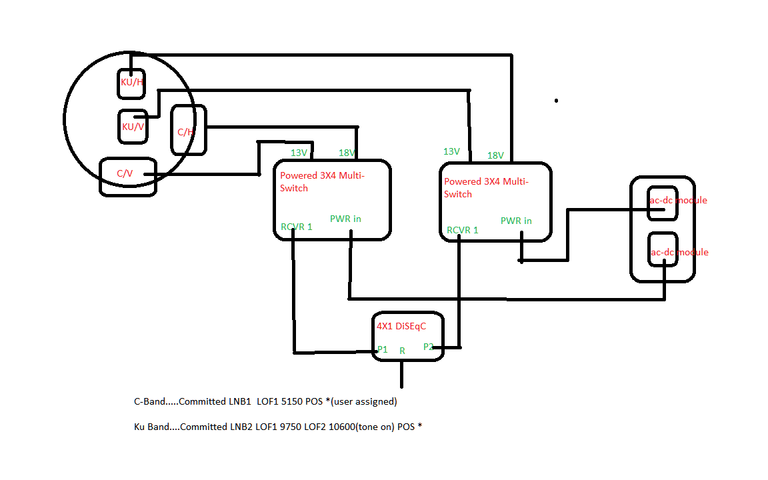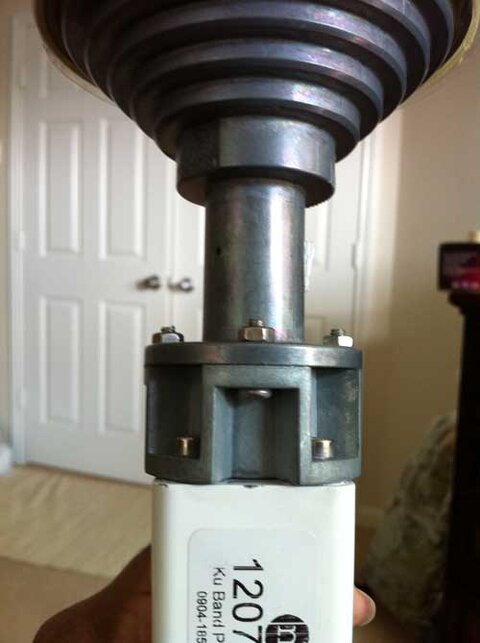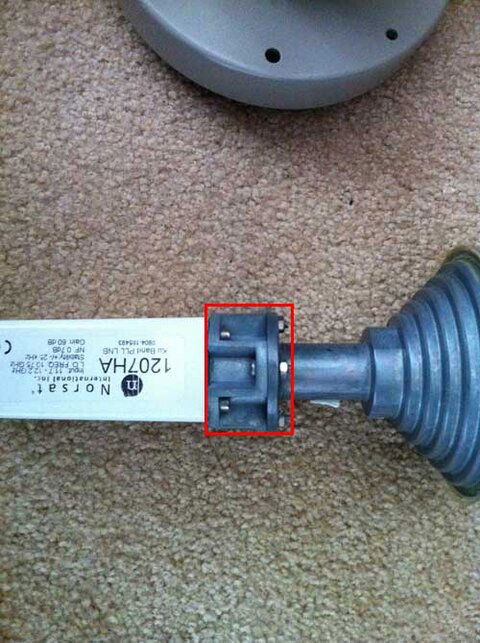The LNBs being powered one at a time thru the switch won't be a problem unless they require more than 13v to run
Bulls Eye II Wide Band Feedhorn - 22 KHZ or voltage select ?
- Thread starter john_robot
- Start date
- Latest activity Latest activity:
- Replies 55
- Views 10K
You are using an out of date browser. It may not display this or other websites correctly.
You should upgrade or use an alternative browser.
You should upgrade or use an alternative browser.
- Status
- Please reply by conversation.
As Anole indicated there are multi switches that don't use tone control which may better suiit our needs
There seems to be so much confusion and weird ideas going on here, that I finally decided to step in.
Chap Wideband feeds - I haven't done a very detailed comparison, but I'm not so sure there is any difference in the bandwidths of their C-band feeds. I've measured "non-wideband" Chap feeds and they work as well on the extended range birds as the 'wideband' versions. The main difference between the two is the 'wideband' versions come with removable circular polarization dielectric plates. Which the OP doesn't intend to use.
C-band switching - on its own this would be the easy part. It generally makes sense to use a multiswitch so the receiver can control polarity in the normal fashion. For wideband applications you would be best to avoid most 3x4 switches as they are often rated only for 950-1450 Mhz use. The WNC 4x8 switch is also only rated for that range, but still works well because its actual bandwidth is somewhat wider. The best multiswitch for wideband use I've tried is the Zinwell 6x8. It is rated from 250-2150 MHz and does better at the high extreme compared to the WNC.
Ku universal LNBs will work fine with dual orthos, but you have to pick your poison if you want the full low/high band range. This is because most FTA switch layouts don't interface well to this arrangement. I've only considered a single receiver as that appears to be OP's plan. Some poisons include:
1. Two single output Ku universal LNBs as suggested by the OP. This should seemingly be easy, but it's kind of a switching mess because the LNBs need a thru-22 kHz to switch from high band to low band. Unfortunately many 3x4, 4x8, 6x8 switches do NOT pass 22 kHz on/off because they normally provide conditioned power to the LNBs. You could use a 4x1 DiSEqC switch with each port connected to one LNB if you're willing to live with receiver-provided power. The catch is you will likely have to program the receiver for a 'pseudo satellite' for each polarization and band for a given orbital position. Something like "Hot Bird n-CH", "Hot Bird n-CV", "Hot Bird n-KuH" an "Hot Bird n-KuV", each switched to the appropriate LNB by DiSEqC. You will also have to program H polarization for every signal to ensure you send +18V to the operating LNB. But you will have 22 kHz switching for Ku-band. If you don't want to keep all of your LNBs powered all the time, your receiver should be perfectly capable of powering one at a time as it will in this configuration.
2. You could use two multiswitches into two ports of a DiSEqC switch along the lines of what Magic Static proposed - if you can find a multiswitch that passes 22 kHz on/off. Otherwise there's a catch here, as you have to get the 22 kHz from the receiver to the Ku LNBs for low/high band switching, which was not considered. This could be implemented in a simple, but custom circuit on top of a couple of traditional power inserters. You can probably safely get by with a diode in the power path and a capacitor that will pass 22 kHz given the low-frequency load presented by the LNB. If you go this route, the Zinwell 6x8 would be the best choice, but you would need two. This is very doable if you don't mind crafting the circuit.
3. As far as I'm concerned, the best technical solution for a dual ortho with universal Ku is to implement something like what I did in the 'Frakenstein' thread. It's true you end up tossing part of the original dual ortho feed, but the performance improves considerably and one has a lot of choices for high quality and lower cost universal LNBs. You will save money compared to the LNBs suggested by the OP. The simplest approach would be to get a single output, universal Ku LNB with a C120 flange. Plug this into one DiSEqC 4x1 port and connect the C-band side through a multiswitch to another DiSEqC port. You could follow my approach with a four-fixed output universal LNB, but that requires two multiswitches along with the DiSEqC 4x1, and for a single receiver it buys you nothing.
Chap Wideband feeds - I haven't done a very detailed comparison, but I'm not so sure there is any difference in the bandwidths of their C-band feeds. I've measured "non-wideband" Chap feeds and they work as well on the extended range birds as the 'wideband' versions. The main difference between the two is the 'wideband' versions come with removable circular polarization dielectric plates. Which the OP doesn't intend to use.
C-band switching - on its own this would be the easy part. It generally makes sense to use a multiswitch so the receiver can control polarity in the normal fashion. For wideband applications you would be best to avoid most 3x4 switches as they are often rated only for 950-1450 Mhz use. The WNC 4x8 switch is also only rated for that range, but still works well because its actual bandwidth is somewhat wider. The best multiswitch for wideband use I've tried is the Zinwell 6x8. It is rated from 250-2150 MHz and does better at the high extreme compared to the WNC.
Ku universal LNBs will work fine with dual orthos, but you have to pick your poison if you want the full low/high band range. This is because most FTA switch layouts don't interface well to this arrangement. I've only considered a single receiver as that appears to be OP's plan. Some poisons include:
1. Two single output Ku universal LNBs as suggested by the OP. This should seemingly be easy, but it's kind of a switching mess because the LNBs need a thru-22 kHz to switch from high band to low band. Unfortunately many 3x4, 4x8, 6x8 switches do NOT pass 22 kHz on/off because they normally provide conditioned power to the LNBs. You could use a 4x1 DiSEqC switch with each port connected to one LNB if you're willing to live with receiver-provided power. The catch is you will likely have to program the receiver for a 'pseudo satellite' for each polarization and band for a given orbital position. Something like "Hot Bird n-CH", "Hot Bird n-CV", "Hot Bird n-KuH" an "Hot Bird n-KuV", each switched to the appropriate LNB by DiSEqC. You will also have to program H polarization for every signal to ensure you send +18V to the operating LNB. But you will have 22 kHz switching for Ku-band. If you don't want to keep all of your LNBs powered all the time, your receiver should be perfectly capable of powering one at a time as it will in this configuration.
2. You could use two multiswitches into two ports of a DiSEqC switch along the lines of what Magic Static proposed - if you can find a multiswitch that passes 22 kHz on/off. Otherwise there's a catch here, as you have to get the 22 kHz from the receiver to the Ku LNBs for low/high band switching, which was not considered. This could be implemented in a simple, but custom circuit on top of a couple of traditional power inserters. You can probably safely get by with a diode in the power path and a capacitor that will pass 22 kHz given the low-frequency load presented by the LNB. If you go this route, the Zinwell 6x8 would be the best choice, but you would need two. This is very doable if you don't mind crafting the circuit.
3. As far as I'm concerned, the best technical solution for a dual ortho with universal Ku is to implement something like what I did in the 'Frakenstein' thread. It's true you end up tossing part of the original dual ortho feed, but the performance improves considerably and one has a lot of choices for high quality and lower cost universal LNBs. You will save money compared to the LNBs suggested by the OP. The simplest approach would be to get a single output, universal Ku LNB with a C120 flange. Plug this into one DiSEqC 4x1 port and connect the C-band side through a multiswitch to another DiSEqC port. You could follow my approach with a four-fixed output universal LNB, but that requires two multiswitches along with the DiSEqC 4x1, and for a single receiver it buys you nothing.
pendragon and Magic Static, thank you for the very informative posts. Although I was interested in satellites since my college days I haven't had chance to explore the techniques such as this.
So this is very good learning experience for me.
So this is very good learning experience for me.
difference of philosophy
I assumed multiple receivers were to be supported.
I'd never build up such a complicated system that could only operate with one receiver.
Not receptive to shortcuts.
So, the complicated custom programming of the receiver, is a no-sale, too.
I assumed multiple receivers were to be supported.
I'd never build up such a complicated system that could only operate with one receiver.
Not receptive to shortcuts.
So, the complicated custom programming of the receiver, is a no-sale, too.
pendragon,
I like the option 3 but confused with "connect the C-band side through a multiswitch to another DiSEqC port"
what do you mean by this ?
I like the option 3 but confused with "connect the C-band side through a multiswitch to another DiSEqC port"
what do you mean by this ?
I assumed multiple receivers were to be supported.
I'd never build up such a complicated system that could only operate with one receiver.
Not receptive to shortcuts.
So, the complicated custom programming of the receiver, is a no-sale, too.
Lol yeah you might laugh I bought Navigator mount system and RC2000A two Thompson actuators that not even touched yet. Just trying to get the basics right. I wish I was a very good tech thinker like you guys.
If I'm going with Option 2. I belive this should do the job - Pico Macom TSMS-2150-5/4 switch

http://200.78.236.213/manuals/pico/TSMS-2150-54.pdf
http://www.saveonvideo.com/Pico_Mac...utm_source=google-shopping&utm_medium=organic
I'm I right ?

http://200.78.236.213/manuals/pico/TSMS-2150-54.pdf
http://www.saveonvideo.com/Pico_Mac...utm_source=google-shopping&utm_medium=organic
I'm I right ?
I just read the whole thing again and got the thing that you mean by "connect the C-band side through a multiswitch to another DiSEqC port"
Ok found the 'Frakenstein' thread http://www.satelliteguys.us/c-band-...nstein-triple-ortho-dual-ortho-universal.html
let me read it
Ok found the 'Frakenstein' thread http://www.satelliteguys.us/c-band-...nstein-triple-ortho-dual-ortho-universal.html
let me read it
I assumed multiple receivers were to be supported.
I'd never build up such a complicated system that could only operate with one receiver.
I agree, but providing multireceiver solutions for someone who plans on only one is still gold-plating. Option 3 with a four fixed output universal LNB can easily support 8 receivers by adding one 4x1 DiSEqC switch per additional receiver. It is the one I would choose (and did).
Not receptive to shortcuts. So, the complicated custom programming of the receiver, is a no-sale, too.
If you want to use OP's original Ku LNB, this is the poison that comes along.
I like the option 3 but confused with "connect the C-band side through a multiswitch to another DiSEqC port" what do you mean by this ?
C-band H LNB -> Multiswitch A, H input port
C-band V LNB -> Multiswitch A, V input port
Ku-band low H LNB out -> Multiswitch B, H input port
Ku-band low V LNB out -> Multiswitch B, V input port
Ku-band high H LNB out -> Multiswitch B, H+22 kHz input port
Ku-band high V LNB out -> Multiswitch B, V+22 kHz input port
Multiswitch A, Output 1 -> DiSEqC input port 1
Multiswitch B, Output 1 -> DiSEqC input port 2
DiSEqC output port -> Receiver
If I'm going with Option 2. I belive this should do the job - Pico Macom TSMS-2150-5/4 switch
No, it will not pass a switched 22 kHz signal through to the universal LNBs. It probably would work with the four fixed output universal LNB described in option 3.
Last edited:
Unfortunately I believe the design of the Ku waveguides on the back end of the Bullseye is preferentially selecting the polarization for each LNB. You might get this to work with some machining, but all it would do is make the path length to the LNBs longer and cause more loss. The Frankenstein approach was partly intended to move the Ku LNB closer to the feed mouth and reduce loss.
Is there any way to identify 22mhz passing switches by looking at the specs? or we have to test it to identify ?
A 3x4 unpowered switch might stand a chance of passing 22 kHz, but it's very unlikely a 4xn or powered switches would. Either way you would have to test each model as this is generally not specified. For the record, I have not been impressed with the electrical performance of the few 3x4 unpowered switches I've measured.
In a word no. pendragon below is correct.I have a question. Without taking out the original KU section of the bulls eye II, cant we use a Wave Guide Adaptor pls see the attachment, to attach two lnb ports? may be we can have one Invacom universal Liner LNB and one Invacom Circular LNB?
View attachment 70133View attachment 70132View attachment 70131
- Status
- Please reply by conversation.
Similar threads
- Replies
- 4
- Views
- 853
- Replies
- 13
- Views
- 804
- Replies
- 4
- Views
- 1K
- Replies
- 9
- Views
- 583
- Replies
- 9
- Views
- 501
Users Who Are Viewing This Thread (Total: 1, Members: 0, Guests: 1)
Who Read This Thread (Total Members: 4)
Latest posts
-
-
-
-
LThis Upgrade Made Me Feel UNSAFE - AMD $5000 Ultimate Tech Upgrade
- Latest: Linus Tech Tips
-
T





